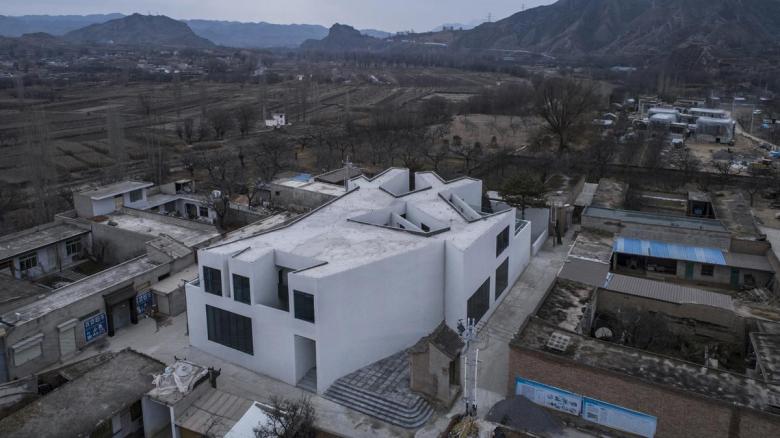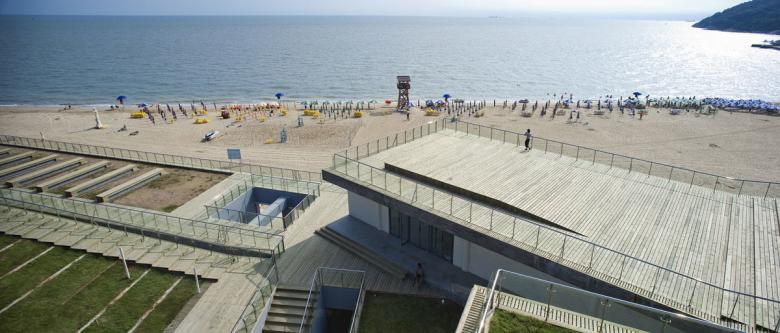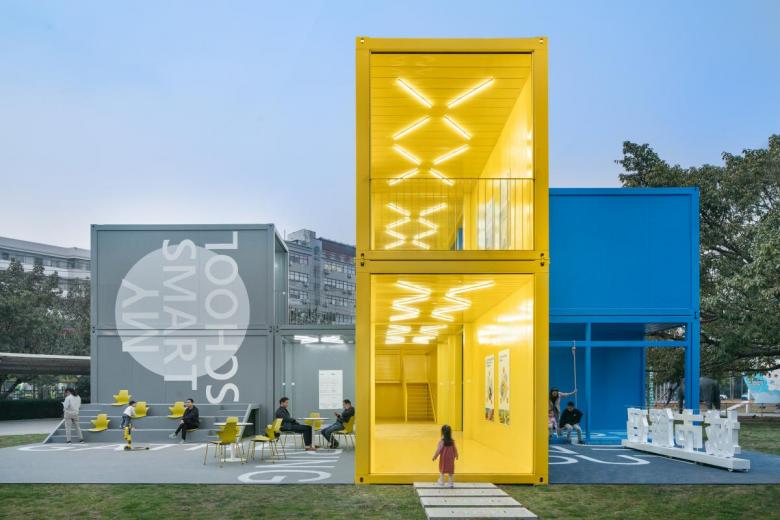Chinese Architects on the Coronavirus Crisis, Part 2
Voices collected by Eduard Kögel
2. april 2020
CU Office: Dongxiang Cultur Center, Maxiang Village, 2019 (Photo: Jin Weiqi)
At the beginning of January, the new coronavirus broke out in the Chinese city of Wuhan and became a pandemic within a few weeks. The measures taken by the Chinese government affected everyone, including architects and the country's entire construction sector. Now that the acute wave of infection in China seems to have stopped, life is gradually returning to normal. But how has the pandemic affected architectural practice and what is the "new normal"?
Is there a learning process from the crisis that will have an impact on architectural or urban planning concepts, e.g. public space?
Chen Xudong, DAtrans Architecture Office, Shanghai
I often think of Frank Lloyd Wright’s Broadacre City and the counter-model, La Ville Radieuse by Le Corbusier. In isolation, I imagine how wonderful it would be if I could at least take a walk outside in my garden and do sports with my child! If you are isolated in the Unité d'Habitation in Marseille, you can only stay in a confined space, since the roof with the playground and the public facilities are sealed: "Please save lives, meetings prohibited." I imagine that I have a virtual boxing match, just like the strong figures, in shorts and vest from the famous sketch of the master.
Xu Tiantian, DnA Design and Architecture, Beijing
Absolutely. The metropolitan areas are most affected by the virus. Rural areas with less density appear to be safer in this crisis. In the long term, this could lead to more people being willing to live in rural areas.
Tan Gangyi, Wuhan
Architecture as the infrastructure of human settlements is designed to protect people’s safety and health. But nowadays we give little priority to material or immaterial environmental factors. Instead of mathematics and geometry in classic architecture, suitable information management and communication tools could create a platform in which everyone can participate (Refabricating Architecture by Stephen Kieran, 2004). Urban planning can format public relations. Based on infrastructure urbanism, the multi-dimensional rating system that combines governance, observability, efficiency, connectivity and diversity is the means of the city’s material and social systems.
Binke Lenhardt, Crossboundaries, Beijing
Every major outbreak of an infectious disease has left its mark and this will be no exception. The peculiarity of the COVID-19 outbreak is that it intersects with the ongoing ecological crisis and rapid technological progress. The temporary benefits of slowing the economy with less pollution and the returning of animals to the city show the fatal effects of our activities on the planet. On the other hand, many traditional services are being switched to automated online platforms. This frees up a lot of physical space. The COVID-19 also gives us a preview of robot-based delivery services, remote work and online versions of exhibitions and events. If we succeed in reducing urban traffic and urban infrastructure, the cities could be less densely populated and large areas could be used for parks or public areas.
Zhu Xiaofeng, Scenic Architecture, Shanghai
It would be very sad if it turned out that people no longer like to go into public spaces. Our current interest has been to explore new spaces for communities. But from now on we have to think differently. I think people still want to meet, mix and gather for common actions. So the architects have to answer the question of what kind of space is flexible enough for assembly and separation.
Brian Zhang Li, Atelier TeamMinus, Beijing
As early as 2003, the SARS crisis led to changes in the ventilation regulations for public interiors. COVID-19 will produce similar reactions worldwide. It appears that COVID-19 will accelerate the digitization of global life and society will need hybrid, flexible, mixed-use physical spaces.
Gong Dong, Vector Architects, Beijing
The virus reveals the weakness and vulnerability of our entire human society. Systems and life can be so fragile when they face the natural catastrophic force. It raises serious questions about the tremendously positive development of globalization because even bad things like COVID-19 can hit our connected world at unprecedented speed. What is the finer mechanism that could bridge and reconcile individuality and collectivity as well as privacy and publicity? These are not new topics, but the circumstances force us to re-examine them.
Scenic Architecture: Dashawan Beach Facilities at Liandao Island, 2008 (Photo courtesy of Scenic Architecture)
How will the crisis affect work processes in the future?
Chen Xudong, DAtrans Architecture Office, Shanghai
This disaster is not over yet. Every day we receive all sorts of messages from neighbors, our friends in Korea, Italy, Germany and around the world that scare us, cause sadness and deprive us of sleep. Sorry, it may not be the right time for the final summary! At this point, I think the disease has indirectly triggered an alarm for the currently booming globalization and urbanization. I have never spoken out against the positive aspects of globalization and urbanization such as economic complementarity, trade and knowledge exchange. But their disadvantages are now becoming apparent and raise the question: is the density of the city a quality in itself? Is it desirable for people to leave the countryside and move to the city? Is the extent of urbanization an important indicator for our civilization?
Brian Zhang Li, Atelier TeamMinus, Beijing
Digitization is the challenge of the hour. A variety of new online design tools and technologies are needed.
Xu Tiantian, DnA Design and Architecture, Beijing
Less travel and therefore less presence on-site.
Binke Lenhardt, Crossboundaries, Beijing
Companies will be more and more able to use the existing technical possibilities for online meetings. We will continuously research and improve digital platforms to increase our productivity, and we will become more flexible in terms of our work place and ultimately we will travel less.
Che Fei, CU Office, Beijing
Social media is becoming an important working tool, and future work in architectural offices is becoming more diverse and complex.
Zhu Xiaofeng, Scenic Architecture, Shanghai
Always be ready to switch between online and offline work.
Tan Gangyi, Wuhan
Online work, remote control and VR technology, especially after the implementation of 5G and other technologies, not only has a major impact on the design, but also on the architecture itself. The production and distribution of knowledge will change, and the combination of online and offline in architecture education and architecture design is becoming more and more common.
Crossboundaries: Infinity 6 Pop-Up School, Shenzhen, 2019 (Photo: BAI Yu)
Based on your experience of the last few weeks, can you give tips for architects in other parts of the world?
Zhu Xiaofeng, Scenic Architecture, Shanghai
Try to work online as much as possible to ensure everyone’s safety. Find a way for daily exercise. Cooking at home can support architectural thinking.
Tan Gangyi, Wuhan
Please prepare a computer with handwriting capacity that can make your design communication more direct and smooth. It would be even better to have VR with related software and terminals. Keep social distance and avoid any unnecessary contact. Wash your hands frequently, which is more important than eye protection when fighting COVID-19. Take breaks, exercise at home and keep your state of mind up. After all, architectural design is the perfect job to deal with beautiful things and to use your wisdom to improve our living environment.
Binke Lenhardt, Crossboundaries, Beijing
In the office you need all kinds of hygiene measures and sufficient distance between workplaces to create a safe and balanced work situation. Each person deals with this situation differently and may need mental support. It is our office culture to openly discuss problems and look for solutions. In practical terms, some employees have to work from home. In general, be proactive in finding new software to improve communication with third parties. Be aware of what’s going on around you, keep an eye on the situation and policy changes so you can respond in time. In general, we believe it is necessary to remain positive at all times and to face the challenges creatively in order to become resilient and better prepared for future difficulties.
Chen Xudong, DAtrans Architecture Office, Shanghai
Personally, I also used this time to focus on reading and translating a number of professional architectural documents. Thanks to the guidance of the ideas of Gottfried Semper, Hendrik Petrus Berlage and Adolf Loos, I was temporarily separated from the viral world outside the window. At the same time, I would like to thank my family and Youme (our little cat) for their company, because together with them I have spent the most memorable and warmest time in my life.
Gerelateerde artikelen
-
Chinese Architects on the Coronavirus Crisis, Part 2
on 02-04-2020
-
Chinese Architects on the Coronavirus Crisis, Part 1
on 02-04-2020


